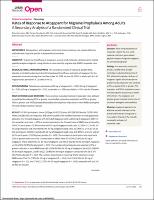| dc.contributor | Vall d'Hebron Barcelona Hospital Campus |
| dc.contributor.author | Lipton, Richard B |
| dc.contributor.author | Pozo Rosich, Patricia |
| dc.contributor.author | Blumenfeld, Andrew M |
| dc.contributor.author | Dodick, David W |
| dc.contributor.author | McAllister, Peter |
| dc.contributor.author | Li, Ye |
| dc.date.accessioned | 2022-09-08T12:04:09Z |
| dc.date.available | 2022-09-08T12:04:09Z |
| dc.date.issued | 2022-06-01 |
| dc.identifier.citation | Lipton RB, Pozo-Rosich P, Blumenfeld AM, Dodick DW, McAllister P, Li Y, et al. Rates of Response to Atogepant for Migraine Prophylaxis Among Adults: A Secondary Analysis of a Randomized Clinical Trial. JAMA Netw Open. 2022 Jun 1;5(6):e2215499. |
| dc.identifier.issn | 2574-3805 |
| dc.identifier.uri | https://hdl.handle.net/11351/8079 |
| dc.description | Migraine; Atogepant; Adults |
| dc.description.abstract | Importance Some patients with migraine, particularly those in primary care, require effective, well-tolerated, migraine-specific oral preventive treatments.
Objective To examine the efficacy of atogepant, an oral, small-molecule, calcitonin gene–related peptide receptor antagonist, using 4 levels of mean monthly migraine-day (MMD) responder rates.
Design, Setting, and Participants This secondary analysis of a phase 3, double-blind, placebo-controlled randomized clinical trial evaluated the efficacy and safety of atogepant for the preventive treatment of migraine from December 14, 2018, to June 19, 2020, in adults with 4 to 14 migraine-days per month at 128 sites in the US.
Interventions Patients were administered 10 mg of atogepant (n = 222), 30 mg of atogepant (n = 230), 60 mg of atogepant (n = 235), or placebo (n = 223) once daily in a 1:1:1:1 ratio for 12 weeks.
Main Outcomes and Measures These analyses evaluated treatment responder rates, defined as participants achieving 50% or greater (α-controlled, secondary end point) and 25% or greater, 75% or greater, and 100% (prespecified additional end points) reductions in mean MMDs during the 12-week blinded treatment period.
Results Of 902 participants (mean [SD] age, 41.6 [12.3] years; 801 [88.8%] female; 752 [83.4%] White; 825 [91.5%] non-Hispanic), 873 were included in the modified intention-to-treat population (placebo, 214; 10 mg of atogepant, 214; 30 mg of atogepant, 223; and 60 mg of atogepant, 222). For the secondary end point, a 50% or greater reduction in the 12-week mean of MMDs was achieved by 119 of 214 participants (55.6%) treated with 10 mg of atogepant (odds ratio, 3.1; 95% CI, 2.1-4.6), 131 of 223 participants (58.7%) treated with 30 mg atogepant (odds ratio, 3.5; 95% CI, 2.4-5.3), 135 of 222 participants (60.8%) treated with 60 mg of atogepant (odds ratio, 3.8; 95% CI, 2.6-5.7), and 62 of 214 participants (29.0%) given placebo (P < .001). The numbers of participants who reported a 25% or greater reduction in the 12-week mean of MMDs were 157 of 214 (73.4%) for 10 mg of atogepant, 172 of 223 (77.1%) for 30 mg of atogepant, and 180 of 222 (81.1%) for 60 mg of atogepant vs 126 of 214 (58.9%) for placebo (P < .002). The numbers of participants who reported a 75% or greater reduction in mean MMDs were 65 of 214 (30.4%) for 10 mg of atogepant, 66 of 223 (29.6%) for 30 mg of atogepant, and 84 of 222 (37.8%) for 60 mg of atogepant compared with 23 of 214 (10.7%) for placebo (P < .001). The numbers of participants reporting 100% reduction in mean MMDs were 17 of 214 (7.9%) for 10 mg of atogepant (P = .004), 11 of 223 (4.9%) for 30 mg of atogepant (P = .02), and 17 of 222 (7.7%) for 60 mg of atogepant (P = .003) compared with 2 of 214 (0.9%) for placebo.
Conclusions and Relevance At all doses, atogepant was effective during the 12-week double-blind treatment period beginning in the first 4 weeks, as evidenced by significant reductions in mean MMDs at every responder threshold level. Higher atogepant doses appeared to produce the greatest responder rates, which can guide clinicians in individualizing starting doses. |
| dc.language.iso | eng |
| dc.publisher | American Medical Association |
| dc.relation.ispartofseries | JAMA Network Open;5(6) |
| dc.rights | Attribution-NonCommercial-NoDerivatives 4.0 International |
| dc.rights.uri | http://creativecommons.org/licenses/by-nc-nd/4.0/ |
| dc.source | Scientia |
| dc.subject | Migranya - Tractament |
| dc.subject | Avaluació de resultats (Assistència sanitària) |
| dc.subject.mesh | Migraine Disorders |
| dc.subject.mesh | /drug therapy |
| dc.subject.mesh | Treatment Outcome |
| dc.title | Rates of Response to Atogepant for Migraine Prophylaxis Among Adults: A Secondary Analysis of a Randomized Clinical Trial |
| dc.type | info:eu-repo/semantics/article |
| dc.identifier.doi | 10.1001/jamanetworkopen.2022.15499 |
| dc.subject.decs | trastornos migrañosos |
| dc.subject.decs | /farmacoterapia |
| dc.subject.decs | resultado del tratamiento |
| dc.relation.publishversion | http://dx.doi.org/10.1001/jamanetworkopen.2022.15499 |
| dc.type.version | info:eu-repo/semantics/publishedVersion |
| dc.audience | Professionals |
| dc.contributor.organismes | Institut Català de la Salut |
| dc.contributor.authoraffiliation | [Lipton RB] Department of Neurology, Albert Einstein College of Medicine and the Montefiore Headache Center, Bronx, New York. [Pozo-Rosich P] Unitat de Cefalea, Servei de Neurologia, Vall d’Hebron Hospital Universitari, Barcelona, Spain. Grup de Recerca en Cefalea i Dolor Neurològic, Vall d'Hebron Institut de Recerca (VHIR), Barcelona, Spain. Universitat Autònoma of Barcelona, Bellaterra, Spain. [Blumenfeld AM] The San Diego Headache Center and The Los Angeles Headache Center, Carlsbad, California. [Dodick DW] Department of Neurology, Mayo Clinic, Scottsdale, Arizona. [McAllister P] New England Institute for Neurology and Headache, Stamford, Connecticut. [Li Y] AbbVie, Madison, New Jersey |
| dc.identifier.pmid | 35675076 |
| dc.identifier.wos | 000809213200001 |
| dc.rights.accessrights | info:eu-repo/semantics/openAccess |

